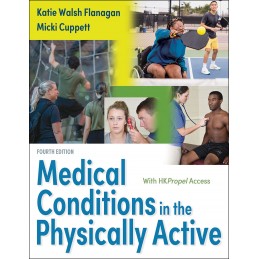Medical Conditions in the Physically Active, Fourth Edition With HKPropel Access, assists athletic trainers and other allied health care providers in recognizing and identifying medical conditions in athletes and active individuals. The book addresses medical conditions by body system, their mechanism of acquisition, signs, symptoms, differential diagnoses, referral, treatment, return-to-participation criteria, and potential comorbidities.
Previously titled
Medical Conditions in the Athlete, this fourth edition uses current research to offer assessment and treatment information for medical conditions that affect both athletes and active populations. The highly esteemed authors, Katie Walsh Flanagan and Micki Cuppett, have combined their professional skills and educational expertise to create a valuable athletic training resource with updated content that aligns with Board of Certification (BOC) and Commission on Accreditation of Athletic Training Education (CAATE) standards. The fourth edition offers the following updates::
- A new section on acute respiratory illnesses, including COVID-19 and SARS
- A new section on gastrointestinal disorders
- A new chapter on endocrine disorders
- Expanded content on concussion detection, treatment, and management, including return to play guidance
- New photos presenting medical conditions on diverse skin colors to help students learn identification skills
- Two to four case studies per chapter, delivered through HKPropel, to provide students with real-world examples; the case studies include multiple-choice questions that are assignable and automatically graded
The book is organized into three sections-Introduction to Medical Conditions, Pharmacology and Interventions, and Medical Conditions by System-and there are 18 comprehensive chapters. Throughout the text, more than 350 full-color illustrations and photographs visually enhance readers comprehension of anatomy, physiology, and pathophysiology. Pharmacological tables organize drugs by categories that include generic and trade names, therapeutic uses, adult dosage information, and possible adverse effects. Important terminology is highlighted throughout the chapters, and a glossary appears at the end of the text. Chapter objectives and chapter summaries assist students in finding key information. Chapter quizzes, which are automatically graded, may also be assigned to test comprehension of critical concepts.
At the beginning of the text, a Condition Finder serves as a quick reference so students or clinicians can easily flip to the information they need on specific conditions. Throughout the book, Red Flags for Urgent Intervention offer warning signs that health care providers should look for when working with patients; Clinical Tips discuss information that is critically important to professionals; and Condition Highlights cover specific medical conditions common to athletes and the physically active that require special attention or medical care.
Medical Conditions in the Physically Active, Fourth Edition With HKPropel Access, provides comprehensive medical information to help readers build a framework for decision making that will help them choose effective courses of treatment.
Note:: A code for accessing HK
Propel is included with this digital version.


 Dostawa
Dostawa
 Płatność
Płatność
 Zwroty
Zwroty
